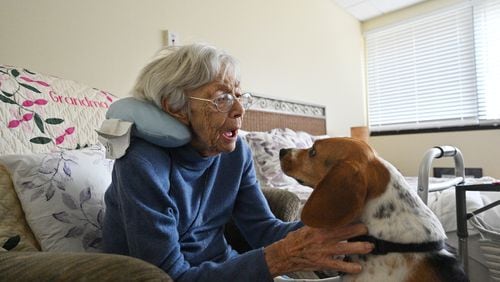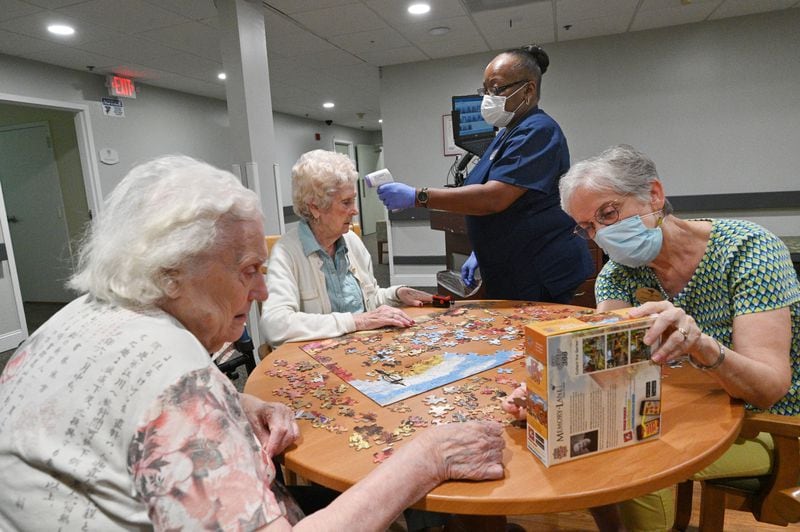The pandemic upended the assisted living industry in Georgia and across the country, driving up costs, devastating occupancy rates and creating a marketing nightmare even though many of the private-pay facilities had few COVID-19 deaths.
A recent report revealed that Atlanta’s senior housing and assisted living facilities have been among the nation’s hardest hit. The National Investment Center for Seniors Housing and Care (NIC) report issued this month found the occupancy rate for senior housing in the metro area is the second lowest among the 31 largest markets.
Assisted living and memory care fare a little better, ranking 20th in occupancy rate at 73.1%, but they still lag the national average by more than 2 percentage points.
Now the senior care industry is hoping relief will be on the way. The state was projected to receive $17.4 billion in federal funds from the American Rescue Plan Act that was adopted this spring. Some $4.8 billion is to help businesses, including long-term care facilities, impacted by the pandemic.
Without help, the industry says, some senior-care facilities may not survive.
Gov. Brian Kemp’s office issued a statement saying long-term care facilities have received a significant amount of support from the state throughout the pandemic.
They “will have the opportunity to submit applications through the ARPA application process that will meet the eligibility and reporting requirements required by Treasury,” according to Kemp’s office.
Rep. John Lahood, R-Valdosta, is on one of the committees that Kemp appointed to help make funding recommendations. The committees are slated to hold an introductory meeting on Thursday and will begin reviewing applications next month.
LaHood is CEO of a family-owned senior care business that operates five facilities in South Georgia. He estimates the industry has lost hundreds of millions of dollars during the pandemic from lost occupancy and increased costs. Currently many homes are operating with occupancy rates below 70%, well below what they need to be profitable.
The visitor restrictions put in place by the state at the height of the pandemic were necessary but contributed to a lingering stigma, he said.
“They were devastating to our business model and the lifestyle we like to create,” he said.
Even with positive signs in recent months, such as a dramatic decline in infections and more new move-ins by residents, residual impacts from the pandemic have created challenges.
“Long-term we’re expecting a pretty good rebound, but the recovery is not happening as fast as it is on other business types,” he said. “We’re doing whatever it takes. The question is how much longer can this last.”
Compounding the problem is that the private-pay senior housing market in the Atlanta area was overbuilt before the pandemic hit. Many new facilities have opened in the past few years, outpacing an uptick in move-ins, according to Beth Mace, chief economist for NIC.
While operators are trying to increase occupancy, they also are under pressure to manage expenses, Mace said.
Credit: HYOSUB SHIN / AJC
Credit: HYOSUB SHIN / AJC
The rising costs include everything from food to supplies such as gloves that have almost tripled in price, said Beth Cayce, CEO of CaraVita Senior Care, which manages the non-profit Woodland Ridge assisted living facility in Smyrna.
“We were hit hard,” she said.
Labor costs are also rising, and some facilities are still struggling to get enough employees to operate.
“It’s putting a huge stress (on everyone),” Cayce said.
Nursing homes also seeking funding
Georgia nursing homes, which recorded about 30% of the state’s COVID-19 deaths, are also hoping to get access to the latest round of federal rescue funds.
Occupancy rates for nursing homes, which serve many patients on government-funded programs such as Medicare and Medicaid, are hovering around 71%. That’s below the national average, according to Tony Marshall, president of the Georgia Health Care Association, which represents the industry.
He said a complex set of factors have limited occupancy. Some facilities have limited admissions because of worker shortages, while others are not seeing the pipeline of patients in need of rehab because of fewer surgeries. Still, some facilities in rural areas are suffering an occupancy shortage because of population limitations.
He said the industry is seeking some formula to pay nursing homes based on pre-pandemic occupancy.
Without such help, some facilities may not make it, he said.
“We’re at a critical juncture where we know there are providers that are going to have to make very difficult decisions about future operations,” he said. “At the end of the day, it’s about what we are able to do to provide quality care to the elderly and disabled in Georgia.”
The largest nursing home operator in the state, PruittHealth, based in Norcross, has turned to a more aggressive marketing campaign, including during Atlanta Braves broadcasts.
It has a new ad going up later this week announcing that the last visitor restrictions are being lifted at its facilities. Families will now be able to visit without scheduling appointments, similar to pre-pandemic policies.
“We are doing everything we can to get people back in our buildings,” said CEO Neil Pruitt Jr. “We’re leaving no stone unturned.”
Still, he said the company has closed one facility in North Carolina and may have to look at closing others because of the financial toll of the pandemic and changing expectations from consumers.
Occupancy across its system was around 89% pre-pandemic, and it’s now around 70%. Past government support has helped, but Pruitt said until the facilities reach 85% occupancy, they will lose money.
“The business model is not sustainable at 70% occupancy,” he said. “We need support until things catch up. That’s going to take time.”
OUR REPORTING
The Atlanta Journal-Constitution has been reporting for more than two years on how the senior care industry in Georgia became overbuilt. In 2019, the newspaper reported how this gold rush mentality had led to a flood of investors seeking to cash in on aging baby boomers. This led some facilities to become financial distressed and care suffered. When the pandemic took hold last year, it collided with these forces, further imperiling an industry that was already facing financial challenges.








